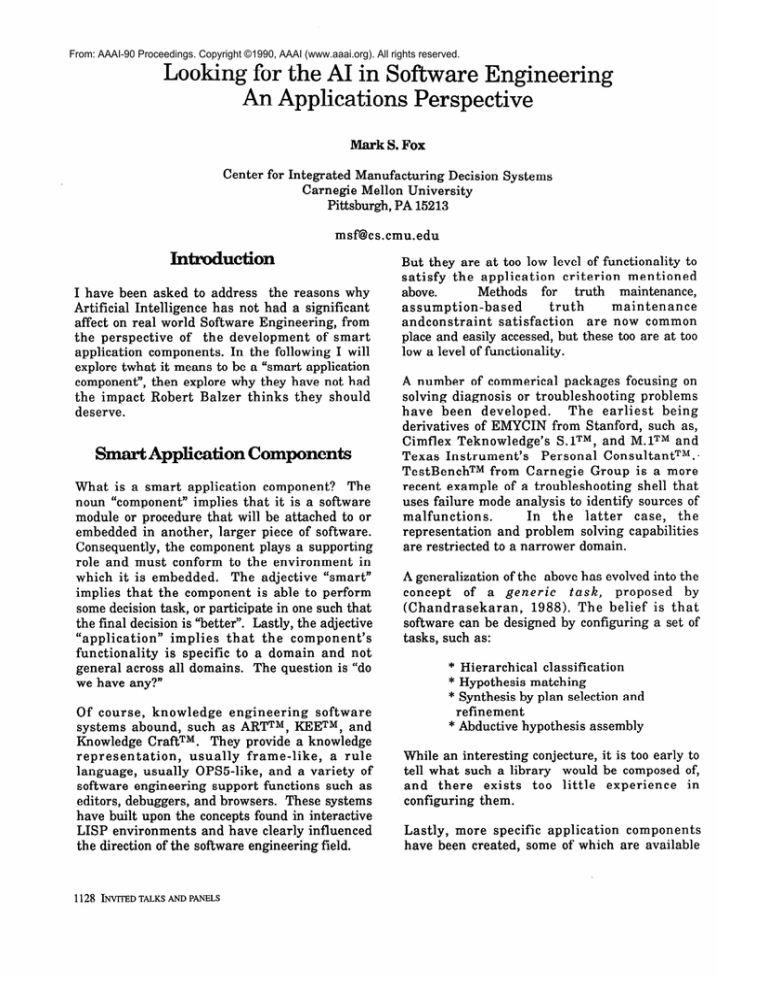
From: AAAI-90 Proceedings. Copyright ©1990, AAAI (www.aaai.org). All rights reserved.
Looking for the AI in Software Engineering
An Applications Perspective
Mark S. Fox
Center for Integrated Manufacturing
Decision
Carnegie Mellon University
Pittsburgh, PA 15213
Systems
msf@cs.cmu.edu
htiuction
I have been asked to address
the reasons why
Artificial
Intelligence
has not had a significant
affect on real world Software Engineering,
from
the perspective
of the development
of smart
application
components.
In the following
I will
explore twhat it means to be a “smart application
component”, then explore why they have not had
the impact Robert Balzer thinks they should
deserve.
t3martApplicationComponents
What is a smart application
component?
The
noun “component”
implies that it is a software
module or procedure that will be attached to or
embedded in another, larger piece of software.
Consequently,
the component plays a supporting
role and must conform to the environment
in
which it is embedded.
The adjective
“smart”
implies that the component
is able to perform
some decision task, or participate in one such that
the final decision is “better”. Lastly, the adjective
“application”
implies
that the component’s
functionality
is specific
to a domain and not
general across all domains.
The question is “do
we have any?”
Of course,
knowledge
engineering
software
systems abound, such as ARTTM, KEETM, and
Knowledge
Craft?.
They provide a knowledge
representation,
usually
frame-like,
a rule
language,
usually OPS5-like,
and a variety of
software engineering
support functions
such as
editors, debuggers, and browsers.
These systems
have built upon the concepts found in interactive
LISP environments
and have clearly influenced
the direction of the software engineering field.
1128
INVITED TALKS AND PANELS
But they are at too low level of functionality
to
satisfy
the application
criterion
mentioned
truth
maintenance,
above.
Methods
for
maintenance
truth
assumption-based
andconstraint
satisfaction
are now common
place and easily accessed, but these too are at too
low a level of functionality.
A number of commerical
packages focusing
on
solving diagnosis
or troubleshooting
problems
have been
developed.
The earliest
being
derivatives
of EMYCIN from Stanford, such as,
Cimflex Teknowledge’s
S.lTM, and M.lTM and
Texas Instrument’s
Personal
ConsultantTM:
Group is a more
TestBench TM from Carnegie
recent example of a troubleshooting
shell that
uses failure mode analysis to identify sources of
In the
latter
case,
the
malfunctions.
representation
and problem solving capabilities
are restriected to a narrower domain.
A generalization
of the above has evolved into the
concept
of a generic
task,
proposed
by
1988). The belief
is that
(Chandrasekaran,
software can be designed by configuring
a set of
tasks, such as:
* Hierarchical
classification
* Hypothesis matching
* Synthesis by plan selection and
refinement
* Abductive hypothesis assembly
While an interesting conjecture, it is too early to
tell what such a library
would be composed of,
and there
exists
too little
experience
in
configuring
them.
Lastly,
more specific
appl ication
have been created, some of which
components
are available
commercially.
These include, knowledge
based
simulation
packages
such as Simulation
Craft
Group
and
Simkit
from
from
Carnegie
factory
scheduling
packages,
Intellicorp,
mechanical
design systems,
process planners,
etc.
It is clear that Artificial Intelligence has begun to
produce smart application
packages,
but only
recently.
Given that there exist components
that could
potentially be embedded in another system, what
has curtailed their use?
The answer is LISP.
Historically,
LISP could not be run as an
embedded
module within a larger application.
Either its need to be the “master” process, and/or
its size has been the problem.
While many
believe
that if this problem
is solved, these
components will find greater use, the percpetion
is false. The real problem is that industry does
not want to train their employees to program in
LISP, no matter what the AI community perceives
its benefits to be. Training
programmers
in a
new language is expensive, and managers loathe
spending
large amounts
on learning
what is
essentially
a fringe language with questionable,
in their eyes, benefits.
The momemtum
that
exists in industry today is to standardize
on a
single operating
system, such as UNIX, and a
single programming
language, such as C/C++.
is in the
air.
Neuron
Data’s
Change
NEXPERTTM
is C-based and embedable.
The
recently announced IMKA consortium, composed
of
Digital
Equipment,
Ford Motor,
Texas
Instruments,
USWest, and Carnegie Group has
as its goal to create
a C-based
knowledge
representation
system and library of application
representations
that are efficient, embedable and
portable.
that we now have several to choose from. And in
some areas, such as factory
scheduling
and
project management
an attempt has been made
towards
crating libraries
(Sathi et al., 1985).
Only Lenat’s CYC project at MCC has pushed the
representational
frontier,
and more recently,
DARPA, NSF and AFOSR convened a workshop
to promote the reusability
of representations.
Never the less, AI application
builders tend to
build their representations
from scratch.
It is clear that there are not many AI-based smart
application components available.
It follows then
that they should have little impact on software
engineering.
On the other hand, what modules
are available tend to be written LISP, crippling
their adoption by industry.
The only positive
statement
one could make, is that software
engineering has yet to achieve the “holy grail” of
resuability
either.
ferences
Chandrasekaran,
B., (19SS), “Generic tasks as
building
blocks for knowledge-based
systems:
the diagnosis
and routine
design examples”,
The Knowledge
Engineering
Review, Vol. 3, No.
3, pp. 177-182.
Sathi, A., Fox, M.S., and Greenberg,
M., (1985),
“Representation
of Activity
Knowledge
for
Project Management”,
IEEE Transactions
on
Pattern Analysis and Machine Intelligence,
Vol.
PAMI-7, No. 5, pp. 531-552.
ReusableRepresentations
One would think that with the central role that
knowledge
representation
plays in Artificial
Intelligence,
that there would be a greater
availability of representation
libraries.
It is true
that the last ten years has witnessed a flurry of
work in temporal and spatial representations,
so
Fox 1129




